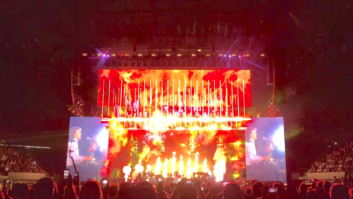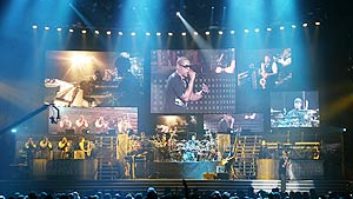Photo: Gordon Mack
He’s been hailed as no less than the savior of the music business by Time magazine, and with chart-toppers such as “Gold Digger,” which features Academy Award — winner Jamie Foxx, Kanye West has certainly achieved superstar status and accrued an enormous fan base. So it’s no surprise that his AKG- and Verizon-sponsored Touch the Sky tour — in support of his Late Registration album — is one of the largest road shows of 2005 and a very tough ticket to come by. But those lucky enough to get in the doors are rewarded with a high-energy show complete with thumping beats, soulful strings and crisp vocals. Mix caught up with the masterminds behind this well-crafted, artistically blended musical Picasso — front-of-house engineer Phil Strong and monitor engineer John Clark — at New York City’s Madison Square Garden in early November.
Strong is mixing on a Digidesign VENUE console, which he has set up to receive 64 channels, although he only uses about 50. He tracks each show to Pro Tools via a Mac G4 PowerBook and 7,200 rpm FireWire G-Technology hard drive. He uses these recordings to go over the songs and mixes with West and the rest of musicians on a nightly basis.
“[The artists and musicians] critique themselves,” says Strong, who also fancies TC Electronic D-Twos for delay and an Eventide Eclipse for occasional pitch bends on West’s vocals. “It’s important to take time to work on your show every day. We all talk about the show and certain music parts. Kanye is really cool; he makes suggestions and communicates, which helps us a lot.”
The biggest element of any hip hop show is always the vocals’ clarity and intelligibility. West sings and raps into an AKG WMS 4000 Series microphone, and with vocals as the primary instrument, Strong builds his mix around them. His main sonic weapon then becomes a Summit Audio TLA-50.
“I got the TLA-50s when I was working with Common two years ago, and I’ve been very happy with them,” says Strong, who purchased four of the tube-leveling amplifiers and uses them on the DJ [A-Trak] and all of the vocalists. “I wanted something that was transparent, that worked without coloring the sound. The Summit unit allowed me to have the vocals pop through, where they are fat and clear, but still in control. That’s what I needed: a little more color control to help place things in the mix.”
“The [AKG WMS 4000] is really cool because you don’t lose the low end when Kanye cups it with his hand,” says Clark. “Kanye hits it hard, but not too hard — not to where it overloads.”
In addition to the main vocals, Strong blends two cellos, four violins, a harp, percussion (congas, ride, crash, hi-hat), a Roland VK8, a Korg MS-2000, a Motif 8ES, an MPC 3000 (kick, snare, snaps, claps), a DJ, a Fender Rhodes 73 Suitcase and two backup singers. As far as the strings are concerned, West only tours with a harpist and a lead violinist; the other three violinists and two celloists are hired guns in each city, who are trained daily.
Front-of-house engineer Phil Strong shows off his rack of goodies.
“The strings are all miked with AKG C 411s, except for the harp and lead violin, which are on Fishman pickups, and the percussion has AKG 391s,” says Clark, who is usually a front-of-house engineer, having worked with the likes of Ray Charles, Jay-Z and Ludacris. “The AKGs give us a consistent sound from venue to venue, which is really important when you have different instruments and musicians on every stop of the tour.”
VISUAL CUES
On many tours, engineers, techs and musicians are able to communicate their audio needs to one another during the show by way of maybe a subtle nod, a facial expression, a secret handshake, etc. But what if the engineers had to make adjustments on the fly without being able to see the musicians, and vice versa? Well, Strong and Clark had to quickly figure it out because they can’t see the performers onstage.
“The musicians are in these 8-foot-by-8-foot boxes with kind of a 70-percent screen on them, and they are covered on all four sides with lights inside of the boxes,” says Strong, who has also worked with Jurassic 5 and the Black Eyed Peas. “You can only see them if they light up from the inside. Sometimes there are video projections on the boxes, so you don’t see the whole show and you are totally relying on your ears. I use headphones more on this tour than I ever have because I can’t see exactly what they are playing. I’ve never had to mix blind like that. They’ll start off visible, then the lighting changes and they can’t see each other either. They are playing strictly off of trust and vibe.”
“I’ve got three techs [Rock, Marcus and Chainey] that are my eyes and ears out there,” concurs Clark, who is using a Yamaha PM5D-RH console with recallable head amps from the floor. “I’ve never been in a situation like this where no one can see each other. So we have our radios and I’ve got those guys running around. We’ve got it down now, but that first week was a real challenge.”
It also helps to work with a first-rate DJ, which they have in A-Trak, a Canadian-born turntable monster who is a five-time World Champion. Clark sends the DJ feed via the Record Out output to his percussionist’s headphones so the music never stops when A-Trak drops the drums out. This way, the percussionist can stay in time and be on cue when the drums return. “It’s really kind of a silly feature that we found a neat way to take advantage of,” jokes Strong, who also uses Serato’s Scratch LIVE on the Serato-endorsed DJ.
Monitor engineer John Clark enjoying the show
MAINTAINING EQUAL COVERAGE
For monitors, West isn’t using in-ears. Instead, Clark has him on eight L-Acoustics 115XT HiQ wedges downstage. In addition, he is using eight (four on each side) L-Acoustics ARCS for the sidefills, with four (two per side) Martin WSX subs underneath.
“With this configuration, I’m really able to get the SPL and hi-fi that Kanye wants,” continues Clark. “That’s my Number One thing when monitoring. I do a lot of live mixing in the sidefills, and with the addition of the orchestra, percussion and keyboards, there is a lot more going on onstage.”
Upstage, Clark has four mixes and a series of in-ear mixes. “The two background singers are on Shure PSM 700 in-ears,” explains Clark, who works through Phoenix-based Genesis Productions, which provided the rig. “And I have two channels on the principle string players, which are the lead violin and harpist. The rest of the musicians are on proprietary FR-12 wedges that Genesis purchased from Audio Analysts. I’ve got a pair of those in the percussionist’s box, a pair on the keyboard side and one for A-Trak, who is centerstage.”
For the tour, Martin Audio provided new prototype 120-degree boxes for the bottom of the rig to improve frontline coverage, helping to disperse the audio for the first four rows of the show. The whole show sports 40 Martin W8L Wavefront line array boxes complemented by 30 Martin WSX subs.
“The Martins are great,” Strong says. “One of the requirements going into this rig was to have something that was hi-fi, and the Martins represented that for us. It sounds really good with the factory settings, and I don’t have to do a lot to the boxes to get them to stand out. Plus, I’m using SIA Software’s SmaartLive, which helps. During the show, I run one side off the reference for the room and the other side on solo, so I can solo any channel and it will give me a representation of what it’s doing on the screen. So if I want to see one instrument, it feeds right to my screen and that helps me EQ during the show.”
And what is it like to work with a megastar like West?
“Working with Kanye, from my standpoint, has been great,” Strong concludes. “He knows how to hold the mic really well and how to keep it at just the right angle. Plus, he believes in working with the best people, so he listens to the input you give him.”
Ray Ellis is a writer covering the pro audio industry.


